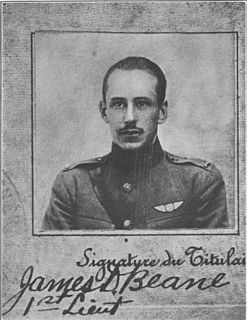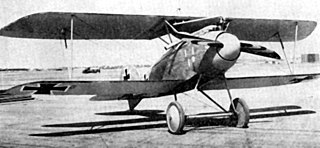Frank Granger Quigley, was a Canadian aviator and flying ace of the First World War, who was credited with 33 aerial victories. He was notable for scoring the majority of his victories against German fighter planes.
Emil Thuy, Pour le Merite, Württemberg's Order of Military Merit, House Order of Hohenzollern, Iron Cross First and Second Class, was one of the leading German fighter aces of World War I, with 35 victories. After the war, he was an adviser to the Finnish air force and was involved in the secret origins of the Luftwaffe within the Soviet Union.
Doctor OberleutnantOtto Schmidt HOH, IC was a German patriot who became a World War I fighter ace credited with 20 aerial victories, including eight against enemy observation balloons. He commanded three different jagdstaffeln (squadrons) as well as a jagdgruppe.
Franz Wognar was an Austrian-Hungarian World War I flying ace credited with five aerial victories who held the rank of Offiziersstellvertreter.

Lieutenant James Dudley Beane was a World War I flying ace credited with six aerial victories.
Tenente ColonnelloAlessandro Buzio was an Italian World War I flying ace credited with six aerial victories, four of them shared.
LeutnantLudwig Luer was a German World War I flying ace credited with six aerial victories.
Lieutenant Arthur Stuart Draisey was a World War I flying ace credited with seven aerial victories.

Lieutenant Jean Chaput was a World War I flying ace credited with 16 aerial victories. He served in the army infantry beginning in 1913. He transferred to aviation in 1914. He qualified as a pilot by February 1915, was assigned to Escadrille 28, and scored his first victory on 12 June 1915 while piloting a Caudron. He was awarded the Médaille militaire for this action. Three days later, he was wounded. On 10 July, he suffered the first of two serious wounds that would cause lengthy interruptions in his flying career. He did not return to duty until January 1916. Having risen through the enlisted ranks to sergeant, he was now commissioned a lieutenant in March 1916. He scored twice more, on 18 March and 30 April; then he was transferred to a fighter squadron, Escadrille 57, in May 1916. Between 22 May and 23 July, he downed an observation balloon and four German airplanes. On 24 August, he was again severely wounded; this time, he would not return to duty until early 1917. He scored a double victory on 5 April, and one each in May and June 1917; the latter was shared with Joseph M. X. de Sévin. There was another lapse in his winning ways, until 23 March 1918, when he once again scored twice; one of his victims that day was Erich Thomas. In April, he succeeded to command of Escadrille 57, and scored his two final victories. He was killed in action on 6 May 1918 by Hermann Becker.
Leutnant Hans von Freden was a World War I flying ace credited with 20 aerial victories.
Leutnant Joachim von Busse was a World War I flying ace credited with eleven aerial victories.
Royal Saxon Jagdstaffel 21 was a "hunting group" of the Luftstreitkräfte, the air arm of the Imperial German Army during World War I. As one of the original German fighter squadrons, the unit would score 148 verified aerial victories, including at least 30 destructions of enemy observation balloons.

Royal Württemberg Jagdstaffel 28, commonly abbreviated to Jasta 28, was a "hunting group" of the Luftstreitkräfte, the air arm of the Imperial German Army during World War I. As one of the original German fighter squadrons, the unit would score 100 verified aerial victories. The Jasta would pay a blood price for its success: nine pilots killed in action, three wounded in action, one injured in a collision, and one prisoner of war.
Royal Prussian Jagdstaffel 33 was a "hunting group" of the Luftstreitkräfte, the air arm of the Imperial German Army during World War I. As one of the original German fighter squadrons, the unit would score a minimum of 46 verified aerial victories.
Capitaine Jean Georges Fernand Matton was a World War I cavalryman and flying ace. He was credited with nine confirmed and two unconfirmed aerial victories.
Royal Bavarian Jagdstaffel 32, commonly abbreviated to Jasta 32, was a "hunting group" of the German Luftstreitkräfte, the air arm of the Imperial German Army during World War I. The unit would score 41 aerial victories during the war, including four enemy observation balloons. In turn, they would suffer the expense of eight killed in action, five killed in flying accidents, four wounded in action, two injured in accidents, and one taken prisoner of war.
Lieutenant Russell Winnicott was an English World War I flying ace credited with ten aerial victories.
Royal Prussian Jagdstaffel 57, commonly abbreviated to Jasta 57, was a "hunting group" of the Luftstreitkräfte, the air arm of the Imperial German Army during World War I. The squadron would score over 32 aerial victories during the war. The unit's victories came at the expense of four pilots killed in action, one injured in a flying accident, four wounded in action, and one taken prisoner of war.
Royal Prussian Jagdstaffel 58, commonly abbreviated to Jasta 58, was a "hunting group" of the Luftstreitkräfte, the air arm of the Imperial German Army during World War I. The squadron would score 24 aerial victories during the war, including nine observation balloons downed. The unit's victories came at the expense of five killed in action, two wounded in action, and one injured in an aviation accident.



